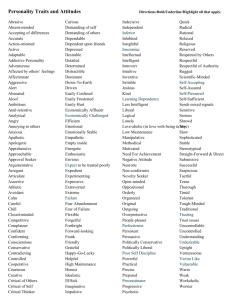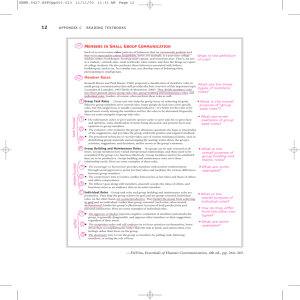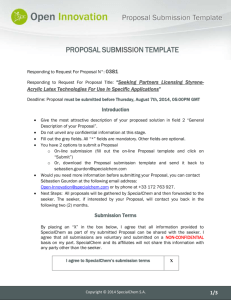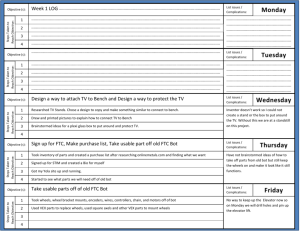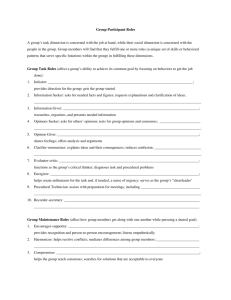CleanSweep_TIreport - TI E2E Community
advertisement
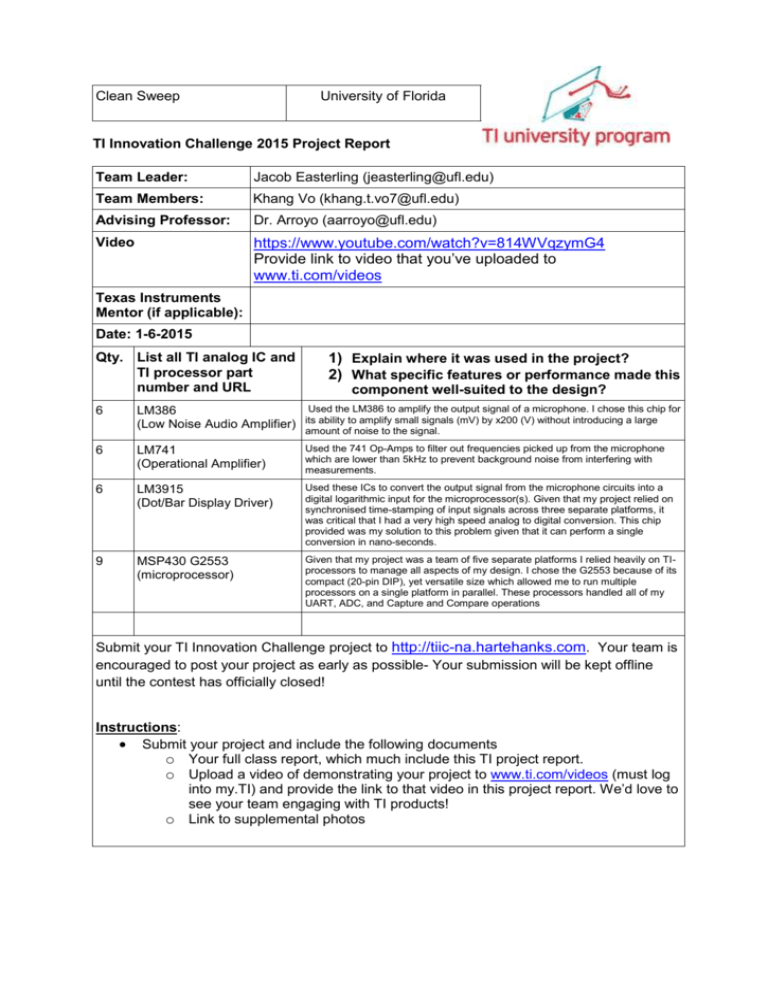
Clean Sweep University of Florida TI Innovation Challenge 2015 Project Report Team Leader: Jacob Easterling (jeasterling@ufl.edu) Team Members: Team Khang Vo (khang.t.vo7@ufl.edu) Advising Professor: Dr. Arroyo (aarroyo@ufl.edu) Video https://www.youtube.com/watch?v=814WVqzymG4 Provide link to video that you’ve uploaded to www.ti.com/videos Texas Instruments Mentor (if applicable): Date: 1-6-2015 Qty. List all TI analog IC and TI processor part number and URL 1) Explain where it was used in the project? 2) What specific features or performance made this component well-suited to the design? 6 Used the LM386 to amplify the output signal of a microphone. I chose this chip for LM386 ability to amplify small signals (mV) by x200 (V) without introducing a large (Low Noise Audio Amplifier) its amount of noise to the signal. 6 LM741 (Operational Amplifier) Used the 741 Op-Amps to filter out frequencies picked up from the microphone which are lower than 5kHz to prevent background noise from interfering with measurements. 6 LM3915 (Dot/Bar Display Driver) Used these ICs to convert the output signal from the microphone circuits into a digital logarithmic input for the microprocessor(s). Given that my project relied on synchronised time-stamping of input signals across three separate platforms, it was critical that I had a very high speed analog to digital conversion. This chip provided was my solution to this problem given that it can perform a single conversion in nano-seconds. 9 MSP430 G2553 (microprocessor) Given that my project was a team of five separate platforms I relied heavily on TIprocessors to manage all aspects of my design. I chose the G2553 because of its compact (20-pin DIP), yet versatile size which allowed me to run multiple processors on a single platform in parallel. These processors handled all of my UART, ADC, and Capture and Compare operations Submit your TI Innovation Challenge project to http://tiic-na.hartehanks.com. Your team is encouraged to post your project as early as possible- Your submission will be kept offline until the contest has officially closed! Instructions: Submit your project and include the following documents o Your full class report, which much include this TI project report. o Upload a video of demonstrating your project to www.ti.com/videos (must log into my.TI) and provide the link to that video in this project report. We’d love to see your team engaging with TI products! o Link to supplemental photos Abstract The purpose of my project was to design and develop a team of robots that could work together clear objects out of a known perimeter. In order to make this possible I identified three elements which each robot needed: situational awareness, communication, and task management. Before we dive into these points let us first identify the task to complete. The task I decided to take on was to use team work to identify and clear all objects out a known area. Situational Awareness This block proposes the questions of “where am I?” and “where are my teammates?” In order to answer these questions I developed a system of three sentry towers which can time stamp a high frequency (roughly 8 kHz) when prompted. The signal is broadcasted by the Seeker Bot (a small robot equipped with an amplified speaker) who will be traversing the known perimeter looking for objects. Once locked on the signal, each tower can relay the distance in-between the Tower and the Seeker Bot to an independent processor (raspberry pi) which will generate an (x,y) coordinates for the object. Communication As is true in any society, communication is the fundamental in order for a team to accomplish any meaningful task. Communication is also foundational in order to orchestrate a team of intelligent machines. To address this each of my robots is equipped with an XBEE wireless Transmitter/Receiver with a unique name (Tower1, Seeker Bot etc.) to allow for a dynamic conversation. Task Management This part might seem intuitive but I have found it is absolutely essential to define what services each robot will provide. Here is an overview of what each team member will contribute the project. Seeker Bot o Moves inside known perimeter looking for obstacles o Broadcasts Homing Signal to Sentry Towers when an object is found Sentry Towers o Time stamps the Homing Signal from Seeker Bot o Sends distance in-between Tower and Seeker Bot to Raspberry Pi. Debris Bot o Sweeps obstacles out of the perimeter Raspberry Pi o Manages all communication on the field o Processes data from Sentry Towers to locate object within in the perimeter Here is a link to my project webpage: https://sites.google.com/site/squadcleansweep/home Please submit your class report with this one page document. Your class report should include the following (Max of 10 pages, excluding appendix): Table of contents List of figures and tables A detailed written description of the project design Hardware Design Any Software Architecture used (include any software code as part of Appendix) Testing and Results / Conclusions Future Work / Recommendations Acknowledgements and/or References Appendix: schematics, CAD drawings, Critical IC Bill of Materials, User Manual, etc.
